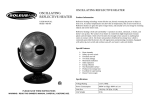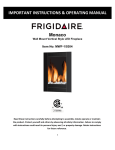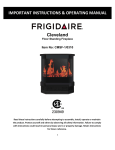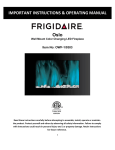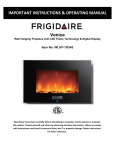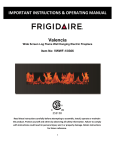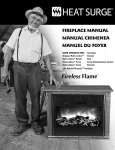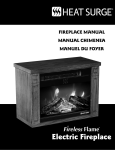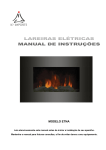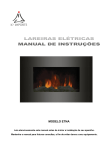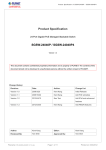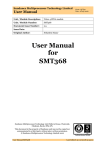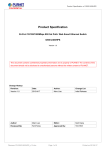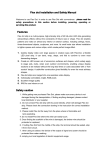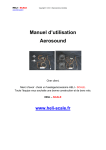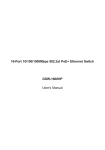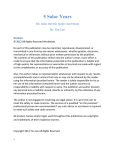Download Heat Surge Model X5C Fire Place Insert Service Manual
Transcript
Heat Surge Model X5C Fire Place Insert Service Manual Applies to all units w/30000208 circuit board ©2012 HS M4417A BR16597R-1 HEAT SURGE 8000 FREEDOM AVE, N. CANTON, OH 44720 330-244-8161 WWW.HEATSURGE.COM 1 Preface This manual is intended for the servicing of the Heat Surge Model X5C fireplace insert. Only authorized trained technicians should use this manual and perform the service needed. Risk of electrical shock, burn and fire is present when performing service to the insert. The following tools are needed: Multi-meter Voltage sensor Flat head screwdriver Phillips head screwdriver Needle nose pliers Side cutters Flashlight Well lighted work area with 120vac switchable source Specifications Model X5C Electric Fireplace Insert 120v/60Hz, 15A, 1500W Quantity 2 clear candelabra bulbs with E-12 (small) sockets, 120vac, 40W, 60HZ Quantity 1 flame tube motor, 120vac, 40ma, 3.7W, 60HZ Quantity 1 blower motor, 120vac, 60HZ Quantity 2 heater elements, 120vac, 750W Dimensions 24"W x 21"H x 10"D 2 Table of Contents Description Page Removal of front grill and top cover 4 Incoming Power 5 Lamps 6 Flame Tube 8 Blower Assembly 10 Dual Element Heater with Fusible Link 13 Touch Pad Control 17 Temperature Pot and Temperature Sensor 18 Remote Control and Remote Control Sensor 19 Log removal and replacement 20 Electrical Drawing 21 3 Removal of Front Grill and Top Cover To remove the front grill, remove 120vac power from insert, locate the 4 mounting screws, 2 on each side. Remove screws and pull front grill out towards the front. Refer to Figure 1. Front grill assembly 4 mounting screws, 2 on each side Figure 1, removal of front grill To remove the top cover, locate the 9 mounting screws, 2 on each side and 5 in the back of the insert. Remove the screws and pull forward while at the same time lifting out. Be careful to not damage the 2 cables running to the main control board. Remove both cables from their respective sockets and remove top. When laying the top down to service the insert, insolate the touchpad and temperature pot being careful not to short out to the insert case ground. Refer to Figure 2. 2 cables, touch pad and pot 5 mounting screws located in rear 4 mounting screws, 2 on each side Figure 2, removal of top cover 4 Incoming Power The incoming power to the insert is 120vac/60Hz and will draw 15amps when running both heater elements at a total of 1500watts. The incoming power, L1, is protected by a circuit breaker located on the back of the insert. Also the insert is protected by a normally closed tip switch in series with the circuit breaker located inside the top left hand side compartment. To reach this switch the top front grill and the top cover must be removed. The hot lead, L1, is landed on terminal AC-L3 on the main control board. Refer to Figure 4. The common, L2, is landed on terminal AC-N4 on the main control board. When the insert is plugged into an 120vac source there should be 120vac between terminals AC-L3 and AC-N4 on the main control board. If not, inspect plug and plug wire for damage. Also check to make sure the 120vac source is not shut off by either a circuit breaker and/or switch controlling the 120vac source. The ground is landed to the case. Refer to Figure 3. Circuit Breaker Main Control Board Tip Switch Figure 3, Main control board location AC-N1 AC-N2 AC-N3 AC-N4 AC-L3 AC-L2 AC-L1 750W 750W FLAME FAN LAMP Figure 4, Main control board terminal locations 5 Lamps There are 2 candelabra lamps each with an E-12 (small) socket base rating voltage 120vac, rating power 40watts. These lamps are located inside the bottom of the insert. Unfasten the 2 screws on the 2 sides of the bottom panel, take out the bottom panel. Refer to Figure 5. 2 Fixing Screw Bottom panel Figure 5, bottom panel screw locations Locate the 2 bulbs in the bottom of the unit. Examine the bulbs to determine which bulb requires replacement. Remove the holding spring on the old bulb and replace the bulb with a new one. Reinstall the holding spring after replacement. Refer to Figure 6. Candelabra bulbs, 120vac, 40watts, E-12 small socket. Holding spring located around each bulb. Figure 6, lamp locations 6 If bulbs refuse to light, check the 2 conductor plug for connection. To examine the plug the front glass must be removed. Locate the 6 mounting screws, 3 on each side, remove all 6 and lift off front glass. Next remove the 3 top screws holding the flame screen; the plug is located on the right hand side. The plug will have a yellow and a white wire on one side and a black and white wire leading to the sockets. Check for good connection. Refer to Figure 7. Front glass mounting screws, quantity 6. Flame screen mounting screws, quantity 3. Figure 7, lamp plug location If the plug connection is good, check for voltage between terminals LAMP and AC-N1 on the main control board, (60vac to 120vac depending flame brightness set point). Refer to Figure 3 and Figure 4, for board and terminal locations, if there isn’t any voltage present, the main control board is defective, replace with a new board. Repair connection, plug in Lamps. 7 Flame Tube The flame tube assembly consists of the flame tube, flame tube motor and mounting brackets. If there isn’t any rolling frame the following needs performed. To access the flame tube assembly the front glass must be removed and the flame screen pulled forward. Refer to Figure 9. Look for any jams that may cause interference of the rotating tube. Next, inspect for the mounting of the flame tube. Make sure the 2 fasteners are present which hold the flame tube in its place. Also check for bent brackets which may have caused the flame tube to fall out. Refer to Figure 8. Flame tube fasteners quantity 2. Flame tube motor. Flame tube brackets, quantity 2. Figure 8 If there isn’t any interference then inspect the flame tube motor. The flame tube is rotated by a 120vac, 60Hz motor drawing 40ma at 3.7watts which is plugged in, located in the same location as the lamp plug. The plug will have a brown and a white wire on one side and a black and black wire leading to the motor. Check for good connection. Refer to Figure 9. Figure 9 8 If the plug connection is good, check for 110vac between terminals FLAME and AC-N1 on the main control board, refer to Figure 1 and Figure 2 for board and terminal locations, if there isn’t any 110vac present the main control board is defective, replace with a new board. If there is 110vac replace the flame motor. Repair connection and plug in. 9 Blower Assembly The front grill and top of the insert must be removed to service the blower assembly. Refer to Figure 1 and Figure 2. Lift the top off but leave the touch pad and temperature pot plugged in, be careful not to short circuit against the insert casing. Rest the top on the casing so that the touch keypad points straight up. Insolate the touch keypad from the casing with cardboard. With 120vac cord plugged in, turn the insert on via the touch keypad. Next select low on the touch keypad, the blower should start running. If it doesn’t slightly tap the blower with a screw driver, if unit starts then the problem is a sticky blower. If the blower doesn’t start, take a voltage reading from the main control board. There should be 120vac between terminal FAN and AC-N2. Refer to Figure 11. If there isn’t 120vac present then the main control board is defective, replace with a new board. Blower Blower Motor 2 stage infrared heating elements Fusible link Heat discharge vent Figure 10, Blower/Heater assembly If the problem is a sticky blower, the blower must be replaced. First with power removed, remove the heat discharge vent from the insert. There are 4 screws, 2 located on each side, remove all 4 and lift straight off. Next remove all wiring associated with the blower motor, heat element and fusible link. The blower motor has 2 black wires which are landed on terminals FAN and AC-N2 of the main control board. Remove these. Refer to Figure 11. AC-N2 FAN Figure 11, blower motor terminals 10 Next the dual heating element has 3 wires associated with it, 2 black and 1 white. The 2 black leads are the 120vac power leads landing on terminals both marked 750W on the main control board. The lower heating element terminal lands on the lower 750W terminal on the main control board and the upper heating element terminal lands on the upper 750W terminal on the main control board. The white common wire is landed on terminal AC-N3 on the main control board, remove all 3 wires from main control board. Refer to Figures 12 and 13. Upper 750W heating element terminal Lower 750W heating element terminal Figure 12 AC-N3 AC-L2 AC-L1 750W, (upper terminal) 750W, (lower terminal) Figure 13, dual element heat and fusible link terminal locations. Next remove the 2 blue fusible link leads from terminals AC-L2 and AC-L1 from the main control board. Refer to Figures 13 and 14. Fusible link and blue leads Figure 14, fusible link location 11 Remove the 4 screws, 2 on each side, holding the blower/heater assembly to the insert. Remove the 4 screws and lift blower/heater assembly off of the insert. Next locate the 4 screws, 2 on each side, attaching the dual element heater to the blower. Remove these screws and remove dual element heater from blower. Refer to Figure 15. Screws holding dual element heater to blower. Figure 15 Replace blower and reverse above procedure to assemble. 12 Dual Element Heater with Fusible Link The front grill and top of the insert must be removed to service the heater assembly. Refer to Figure 1 and Figure 2. Lift the top off but leave the touch pad and temperature pot plugged in, be careful not to short circuit against the insert casing. Rest the top on the casing so that the touch keypad points straight up. Insolate the touch keypad from the casing with cardboard. With 120vac cord plugged in, temperature pot turned to “HI”, turn the insert on via the touch keypad. Next select low on the touch keypad, the blower should start running and 10 seconds later the low heat should start; you will hear the contacts clicking of the control relay on the main control board. If low heat does not come on, check for 120vac at the fusible link. Place common test lead on the common terminal of the dual element heater marked “A” and the hot test lead on the right hand terminal of the fusible link marked “B”. Refer to Figure 16. Common location “A” Left hand side of fusible link location “C” Right hand side of fusible link location ”B” Figure 16, fusible link If 120vac is present, place the hot test lead to the left hand side of the fusible link marked “C” with the common in the same location. Refer to Figure 16. If 120vac is not present let the unit cool down in order to clear the fusible link. Wait 5 minutes and repeat test. When after repeating the test and there isn’t any 120vac present then check for 120vac present between the 750W (lower terminal) and AC-N3 on the main control board. Refer to Figure 17. AC-N3 750W (lower terminal) Figure 17 13 If 120vac is not present then replace the main control board. If 120vac is present then the fusible link is defective, replace the dual element/fusible heater. Next select low on the touch keypad, the blower should start running and 10 seconds later the low heat should start; you will hear the contacts clicking of the control relay on the main control board. Select high heat and you will hear the contacts clicking of the control relay on the main control board. If the clicking is not heard, repeat the above test only for high heat. Check for 120vac between terminals 750W (upper terminal) and AC-N3. If 120vac is not present change out main control board. Refer to Figure 18. AC-N3 750W (upper terminal) Figure 18, high heat 120vac In order to change out the dual element heater, remove blower assembly as described in section “Blower Assembly”. Remove the 4 mounting screws, 2 on each side of the dual element heater. Refer to Figure 19. Remove and replace with new heater assembly. Install blower assembly. Screws holding dual element heater to blower. Figure 19 14 15 16 Touch Pad Control With the insert sitting up-right, plug the insert into a known good 120vac source. The insert will beep once. Turn the insert on, the lights will light up and there will be a rolling flame. If the insert doesn’t beep or the flame and lights turn on instantly or not at all, the touch keypad is defective. Check for ribbon cable leads coming unplugged from both ends. Check to make sure there is a good connection at the main control board socket. Refer to Figures 20 and 21. Thermocouple plug location Temperature low to high pot plug location Remote control sensor plug location Touch keypad plug location Figure 20, plug locations defined on main control board Figure 21, example of ribbon cable coming unplugged from touch pad connector 17 Temperature Pot and Temperature Sensor With the insert sitting up-right, plug the insert into a known good 120vac source. The insert will beep once. Turn the insert on, the lights will light up and there will be a rolling flame. Turn on the low heat. The blower will turn on and 10 seconds later the low heat will come on. If it doesn’t, make sure the temperature pot is turned to the “HI” setting. If low heat doesn’t come on check to make sure the temperature pot is plugged into the main control board. Refer to Figure 20 for location. Also check to see if there is a good connection at the temperature pot. Refer to Figure 22. Figure 22, example of bad connection at temperature pot Check the integrity of the temperature sensor located just behind the main control board. Refer to Figure 23. Check to make sure the sensor is plugged into the main control board. Refer to Figure 20. If there is a problem, the insert will still heat but without the use of the temperature room setting. If all checks out, refer to section “Dual Element Heater and Fusible Link.” Figure 23, temperature sensor location 18 Remote Control and Remote Control Sensor The unit comes with a remote control complete with power on/off button, low/high heat selector and up/ down flame setting. Refer to Figure 24. Flame up/down Heat low/high Power on/off Figure 24, remote control description If remote control refuses to work check battery orientation and integrity. Refer to Figure 25. Figure 25, battery location and orientation. Also check that the remote control sensor, red plug socket, is plugged in properly into the main control board. Refer to Figure 20. Lastly check the location and integrity of the remote control sensor located behind the flame screen. Refer to Figure 26. Figure 26, remote control sensor 19 Log removal and replacement The front glass needs to be removed. Locate the 6 screws, 3 on each side, holding the front glass frame in and remove. Refer to Figure 27. Locate 6 screws, 3 on each side Figure 27 Locate the 4 black rubber plugs, 2 on each side of the insert. Remove rubber plugs and remove the 4 screws holding the log set in the insert. Pull the log set straight out towards the front. Reverse above to install new log set. Refer to Figure 28. Rubber plugs with mounting screws, quantity 4, 2 on each side of insert. Figure 28 20 Electrical Drawing 21





















